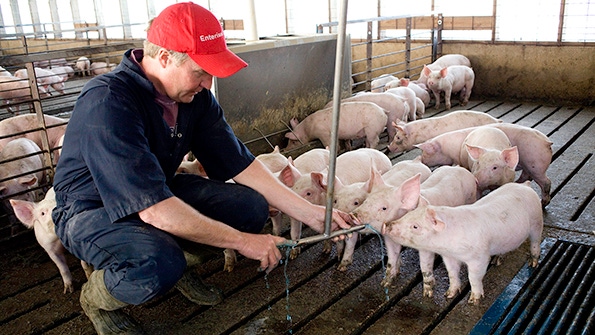Using the correct diagnostic test can help determine both the source and the strain of Salmonella, allowing producers to treat it properly and quickly.
August 30, 2016

Sponsored Content
Among the traditional enteric diseases affecting pigs today Salmonella is one of the most widespread, and one of the most resilient. It can colonize and survive in any organism, from plants to insects to animals. And, with its ability to adapt to new environments Salmonella can survive even the most uninhabitable conditions, making it impossible to eradicate.
“It’s important that we don’t forget that any pig can get it at any time,” says Dr. Julie Funk, professor and associate dean in the College of Veterinary Medicine at Michigan State University. “Since the bacteria is always present, just the slightest dip in immunity or gap in biosecurity can cause an outbreak of clinical Salmonella symptoms throughout a barn or an entire operation.”
Infections caused by Salmonella can present in one of two ways: clinical or subclinical. Clinical signs most often present as diarrhea or septicemia. However, subclinical Salmonella is the more common presentation. “Subclinical infections are common in swine operations. Many studies suggest anywhere from 5 to 20% of individual pigs are subclinically infected (at any one time),” Dr. Funk says. More information on Salmonella infections can be found in the Blueprint for Health column in the July issue of National Hog Farmer.
While diagnosing subclinical Salmonella can be difficult, Dr. Funk recommends using diagnostics to determine if pigs are infected. She explains that there are usually three types of questions that producers want answered to determine the extent of Salmonella infection within the herd.
Q: Is Salmonella causing the disease I’m seeing?
A: Pathological diagnosis – submit tissue samples to the diagnostic lab to test for Salmonella lesions in tissue. If Salmonella is present, the next step is to use a Microbiogical Culture to identify the exact Salmonella serovar.
Q: What Salmonella strains are present in my production system?
A: Microbiological Culture – designed to detect which Salmonella serovar are present via fecal samples or oral fluid testing.
Q: Have these pigs been exposed to Salmonella?
A: Cross sectional or Longitudinal ELISA – multiple samples collected over time designed to detect antibodies to Salmonella in the bloodstream to determine if exposure to Salmonella has occurred. Serum samples or oral fluid samples can be collected for Salmonella ELISA.
“When diagnosing Salmonella, correctly determining the strain of the bacteria your particular pigs are infected with is especially important in treating the bacteria and controlling the disease,” says Dr. Jessica Seate, DVM, a technical manager veterinarian of swine enteric vaccines at Boehringer Ingelheim Vetmedica Inc.
There are 2,500+ strains of Salmonella. Although there are only a small number of those strains, or serovars/serotypes, that will cause severe disease in pigs, each serovar affects your herd differently and therefore needs to be treated differently. Using the correct diagnostic test can help determine both the source and the strain of Salmonella, allowing producers to treat it properly and quickly. This also helps when dealing with a strain resistant to antibiotics, or highly pathogenic strain. Both of these serovars need to be treated with extra care, and diagnostic tests are often the first step to ensuring the disease doesn’t spread further than it has to.
“Producers that are diligent in testing as soon as they suspect disease are most likely to avoid an outbreak and performance losses. By knowing what you’re dealing with, you can solve the problem faster,” says Dr. Seate.
Of these serovars, the one Dr. Funk cautions producers to pay closest attention to is Salmonella Typhimurium, one of the most common strains found on swine farms today. It is also zoonotic, meaning it will infect humans. Dr. Funk recommends producers take preventative measures against this strain, using holistic management techniques to help reduce exposure at the farm level. For more information on these management techniques, look for our next Blueprint for Health column in the September issue of National Hog Farmer.
2016 Boehringer Ingelheim Vetmedica, Inc.
You May Also Like



